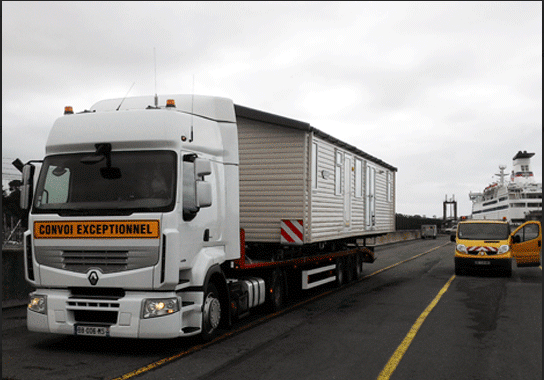Moving House to France – the Basics


Today there are over one million people a year moving between EU member states, and most of them take their home contents with them. Prices for these removals can vary dramatically and service levels likewise. So how can the unwary avoid the pitfalls?
Firstly you should be aware that there is NO fixed price for a removal and the unwary can end up paying well over the odds for a service that should just not cost that much. But is there a REAL difference in the service offered by the expensive companies and the cheaper ones? What everyone wants is a reliable, efficient, friendly service. A company that will turn up when they say, not break all your china, be courteous and deliver your worldly possessions at the time agreed and in one piece.
The problem is how to choose your removal company. To some extent, that depends on your budget and individual needs. Some companies offer complete dismantling services, cleaning services, pet transfer services and more still. These services you will pay for! If, though, you just want to move house and do not want a gold plated delivery van outside your front door, the options are almost limitless! So before you even start to look for a company, decide what level of service you actually need. Once that is done, your search can begin.
Magazine and newspaper adverts and the yellow pages are all good starting points. Any good search engine will provide you with lists of companies that work within Europe. Once this has been done, you can begin your whittling down process. Price will obviously help here, as will the attitude of the person who takes your call. Personal recommendations are best, but failing that there are a number of internet forums where you can ask others on line for their moving experiences. These forums can be very illuminating with some frank comments on various companies.
Research is key. All companies claim to provide an excellent service and the truth of the matter is that 98% of removal companies DO provide an excellent service. The only question is how much should I pay? The rate that you will be quoted is arrived at after a number of factors are taken into consideration, including: load size, distance to be travelled, type of furniture, number of men required and of course operator’s overheads.
To be able to give you a quote that will not vary, you have to be able to provide the removal company with as much detail as possible and here an inventory is essential. In many instances, a visit by the removal company to the house is suggested and can be a good idea. It is not however, compulsory – an experienced estimator will know after talking to you, roughly how much you have to move. A full inventory will make this even easier. Above all, RESIST the temptation to ‘forget’ a few items when telling the removers of the load size. The price differential is minimal and there may not be space on the vehicle for any ‘non declared’ items!
An inventory achieves four important things. Firstly it allows the removal company to know exactly what is to be taken. Don’t forget to include such items as pianos (that may need three men to move them), snooker tables and items such as ride-on lawnmowers and other fragile, bulky, heavy or strange objects. Secondly, in the event of an insurance claim, you can PROVE with an inventory that the removal company had the items concerned. Thirdly, it helps you on unpacking to see where each numbered box should go in the new house. Using a simple spreadsheet will make this even easier, and of course you can then use the same sheet when sorting out your home contents insurance. Lastly, an inventory allows you to re-assess just what you need to take with you. There is, perhaps, little point in taking boxes that have not seen the light of day in years simply to gather dust in another attic.
However, load and distance are not the only elements that affect price. Remember to let any remover know of any problems at either end that could affect delivery or pick up. If you are moving to or from a flat, indicate how many flights of stairs have to be negotiated. Also consider things such as narrow roads (or even ‘no roads’) at either end. It is also as well to check if there are any overhanging trees or wires that could prevent lorries passing underneath.
The ‘DIY’ option
Sometimes costs can be lowered by moving yourself, but often this is not the case. Aside from the cost of vehicle hire, diesel and tolls, there are ‘hidden costs’ to be factored in: taking time off work, ‘paying’ for relatives to assist (food, beer/wine etc), the bruised fingers, the aching backs, the dropped items of furniture, the flaring of tempers, the boredom of driving at 50mph on a motorway and finally having no one to blame for any damaged items. Obtaining insurance for a self move is virtually impossible.
DIY can be an option if you have a small load, plenty of time and are not worried about some seriously hard work. To hire a ‘Luton’ size van and move say 15m3 of furniture from Birmingham to Dordogne will cost you about £1100 all in. This includes hire charges, diesel, ferry and motorway tolls and meals. To ask a removal company to do the same job will cost anything from £1000 to £2500, depending on who you ask.
Choosing to pack up possessions yourself may sound like the obvious choice, but bear in mind that these goods may not be covered under certain insurance policies. This is because insurers cannot be sure that the items were in good condition prior to packing and that they were correctly packed.
As for the actual packing, all companies offer a packing service. This service can extend to cover the ‘packing’ of all of your small items, but you can negotiate to have only some of the goods packed and most companies will provide all the materials you need for this. Note that items of furniture that are packed for European moves are generally ‘blanket’ wrapped in the vehicle. This is adequate for non-container moves.
However, if you are moving further afield and your goods are to be placed in a container, then an ‘export’ pack is highly recommended. Here the furniture etc is bubble wrapped and extra protection afforded to delicate items. The reason for this is that containers on ships move about and damage to contents is not uncommon. Finally, if packing yourself, do not overload your boxes…
To go over all the above:
1. Complete an inventory and be sure that what you are moving really is needed.
2. Check prices at your destination (maybe it’s cheaper to buy a new sofa rather than moving the twenty year old one!)
3. Research your removal company carefully and/or use a brokerage service.
4. Establish exactly what a quote includes (VAT, Insurance, Packing etc)
5. Be sure to let the removal company know of any heavy or bulky items in the load
6. Do let the removers know of any access difficulties (ie: eighth floor with no Lift, or up a small dirt track!!)
7. Start your search for a company between seven and ten weeks before the move date.
8. Ask as many questions as you like from a company or a broker. After all you are entrusting all your possessions to the chosen company!
How can a brokerage help you?
In essence, the broker does exactly the same as you – he solicits quotes from removal companies. The difference is that whereas you ask maybe 10 or 20 companies for quotes, he will ask a few thousand, all over Europe, to quote on your move. The Broker knows when and where companies are going. He is able to approach them directly and suggest that they may like to quote on a job to fill the spare capacity on a vehicle that is passing your front door. Removal companies, like airlines, prefer to travel with full vehicles rather than ones that are half empty. The trick is finding them. This is where the broker can help you to save time, effort and money. Furthermore, an independent brokerage can give you the real story on just how good any one company really is.
See also:
List of removal firms
Share to: Facebook Twitter LinkedIn Email
More in courses, food, insurance, technology, travel, wine, work
By FrenchEntrée
Leave a reply
Your email address will not be published. Required fields are marked *




REPLY
REPLY